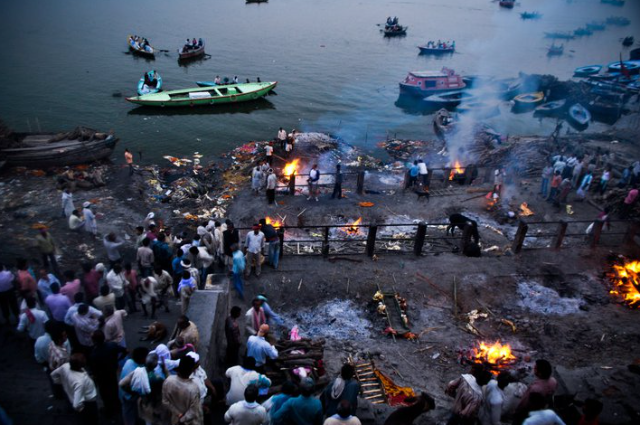Death is one of the few universal experiences that every human being will face, yet how we perceive and deal with it varies greatly across cultures. Some see it as a transition to another existence, while others view it as the ultimate end. Rituals, beliefs, and emotions surrounding death are shaped by religious, historical, and societal influences.
1. Hinduism: Rebirth and Liberation
In Hinduism, death is not the end but a step in the cycle of samsara (reincarnation). Hindus believe that the soul is eternal and undergoes multiple births based on karma (one’s actions in past lives). The ultimate goal is moksha, liberation from the cycle of rebirth, where the soul unites with Brahman, the ultimate reality. Cremation is the most common ritual, as fire is believed to release the soul from the body. The ashes are often scattered in the Ganges River, which is considered sacred.
2. Buddhism: Impermanence and Enlightenment
Buddhists see death as a natural part of existence, emphasizing impermanence (anicca). Like Hindus, they believe in reincarnation, but they strive to achieve nirvana, a state beyond suffering and rebirth. Tibetan Buddhism has elaborate death rituals, including the Tibetan Book of the Dead, which guides the deceased’s consciousness through the transition to a new life. In some traditions, sky burials—where bodies are left for vultures—symbolize the detachment from the material world.
3. Christianity: Judgment and Eternal Life
Christian beliefs about death vary by denomination, but most hold that it leads to judgment. Many Christians believe in an afterlife where souls go to heaven or hell based on their faith and deeds. Some believe in purgatory, a temporary state of purification before entering heaven. Funerals are solemn events with prayers, hymns, and burial or cremation. The concept of resurrection, as seen in the story of Jesus Christ, gives many Christians hope in life after death.
4. Islam: A Test Before the Afterlife
In Islam, death is the beginning of a transition to the Akhirah (afterlife). Muslims believe in Qiyamah (the Day of Judgment), when all souls will be resurrected and judged by Allah. Righteous individuals are rewarded with paradise (Jannah), while wrongdoers face punishment in Jahannam. Islamic funerals are simple, emphasizing humility and quick burials. The body is washed, wrapped in a white cloth (kafan), and buried facing Mecca.
5. Ancient Egyptian Beliefs: Preparing for Eternity
The ancient Egyptians viewed death as the start of a journey to the afterlife, where the deceased’s soul would be judged by Osiris. The heart was weighed against the feather of Ma’at—if it was lighter, the soul could enter the blissful Field of Reeds; if heavier, it was devoured by Ammit, a fearsome creature. Elaborate mummification and burial rituals ensured a safe journey, and tombs were filled with treasures, food, and texts from the Book of the Dead to guide the deceased.
6. Chinese and East Asian Traditions: Ancestor Worship
In many East Asian cultures, including China, Japan, and Korea, ancestor veneration is central to death rituals. Chinese traditions, influenced by Confucianism, Taoism, and Buddhism, hold that the spirits of ancestors influence the living. Offerings, such as food and joss paper (spirit money), are made to provide for them in the afterlife. The Qingming Festival (Tomb Sweeping Day) is an annual event where families clean graves and honour their deceased loved ones.
7. Mexican Day of the Dead: Celebrating the Departed
In Mexico, Día de los Muertos (Day of the Dead) is a vibrant festival where families honour deceased relatives with altars (ofrendas), marigolds, candles, and their favourite foods. Unlike solemn Western funerals, this holiday is a celebration of life, emphasizing that the dead remain spiritually connected to the living. The tradition blends Aztec beliefs with Catholic influences, symbolizing remembrance and joy rather than sorrow.
8. African Traditions: Communal Mourning and Ancestral Connection
Many African cultures see death as a transition to the spiritual realm, where ancestors continue to guide and protect the living. Funerals are large, community-driven events, sometimes lasting days or even weeks. In Ghana, elaborate fantasy coffins shaped like objects that represent the deceased’s life (such as fish for fishermen or planes for pilots) are common. Rituals, songs, and dances help the soul journey to the afterlife and ensure a proper farewell.
9. Indigenous Perspectives: Death as a Part of Nature
Indigenous cultures worldwide often see death as a natural continuation of life. Many Native American tribes believe in cyclical existence, where souls return to nature or are reborn. Some tribes conduct ceremonies to help the soul travel to the Spirit World. The Australian Aboriginals believe in the Dreamtime, where ancestral spirits remain part of the land. These traditions emphasize harmony with nature and respect for those who have passed.
A Universal Experience, a Cultural Perspective
While death is a shared human experience, its meaning and significance vary widely. Some cultures see it as a sorrowful ending, while others embrace it as a new beginning. Rituals, beliefs, and attitudes toward death reflect deeper values—whether it’s the Hindu pursuit of moksha, the Christian hope for resurrection, or the Mexican joy of remembrance. Ultimately, how we perceive death shapes how we live our lives, reminding us of the impermanence of existence and the legacy we leave behind.

